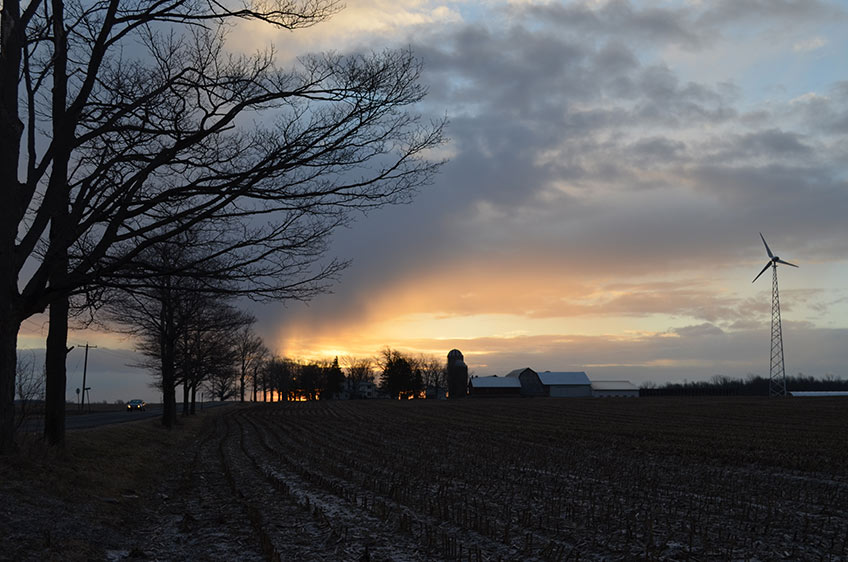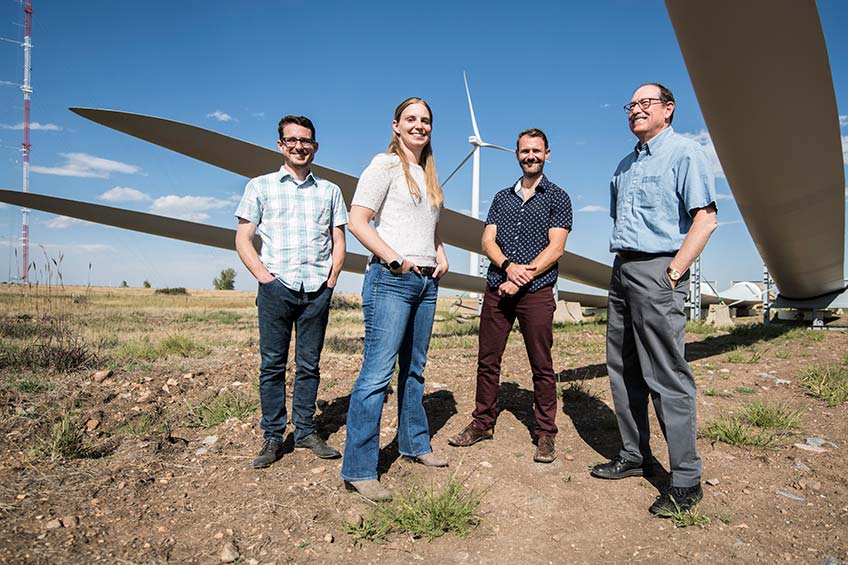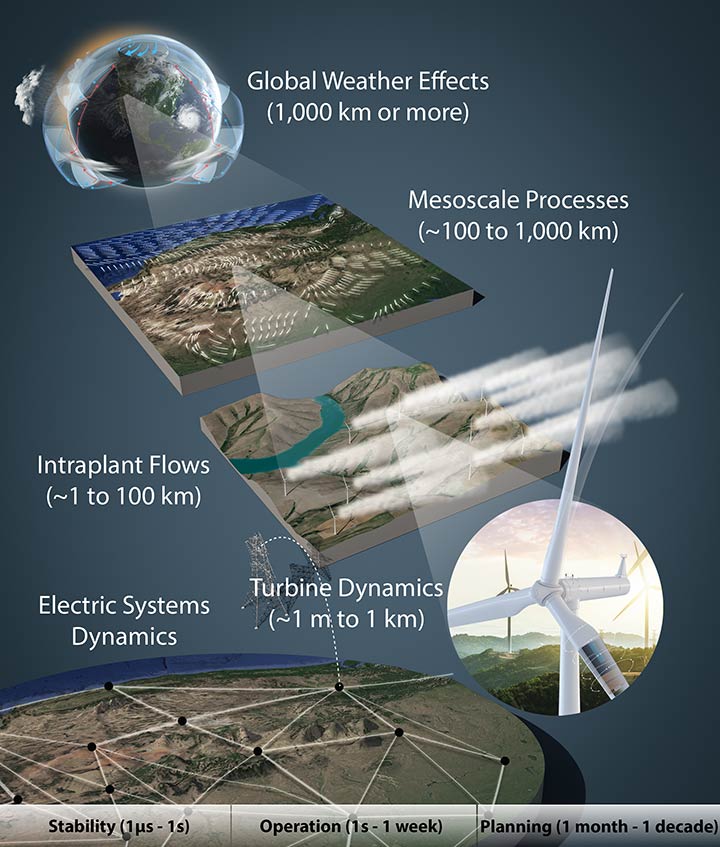The Leading Edge: July 2020 Wind Energy Newsletter
In this edition, distributed wind experts seek to emulate the success of distributed solar technology, we celebrate the 2020 Collegiate Wind Competition, and NREL staff have positive impacts on the local community.
News Stories
Distributed Wind Wonder: International Collaboration To Bring Wind into the Distributed Energy Mainstream
In the not-too-distant past, spotting a solar panel on a rooftop or powering a small health center in a rural community far away from the grid was a rare occurrence. Fast-forward a decade, and the once-rare sighting is now ubiquitous. Could this successful model be applied to wind energy? Researchers from around the world are addressing the challenges that are keeping wind energy from providing similar services.
Shadows of things to come. International researchers are examining a broad spectrum
of solutions involving wind turbines deployed in behind-the-meter, in-front-of-the-meter,
microgrid, and off-grid applications to help drive innovation in distributed wind
technologies. Photo by Padma Kasthurirangan, Niagra Wind and Solar Inc.
Virtual Collegiate Wind Competition Adds New Dimension to Wind Workforce Development
Since 2014, the U.S. Department of Energy's Collegiate Wind Competition has challenged undergraduate students from multiple disciplines to develop unique solutions to complex wind energy challenges in the areas of technical design and wind project development. This year's competition had an interesting hurdle, taking place in a virtual format.
After four days of online presentations in May and June, the Department of Energy announced the winners of the 2020 Collegiate Wind Competition. The award for the Turbine Digital Design contest went to California State University Maritime Academy, and James Madison University claimed the Project Development contest award.
NREL Volunteers Design and Print Face Shields for Colorado Medical Facilities
Summit County firefighters received NREL face shields to stay protected while they
serve their community. Photo by Jenn Oese, Summit Fire & EMS
In response to the COVID-19 pandemic, NREL Flatirons Campus staff are using their research capabilities and resources to contribute to the fight and thank frontline workers.
Since March, about 20 NREL staff members have constructed and delivered more than 1,000 face shields to health care workers, paramedics, and firefighters at 10 health care institutions throughout Colorado.
On the Radar
Chief NREL Engineer Paul Veers Named ASME Fellow
National Wind Technology Center Chief Engineer Paul Veers has been named an American Society of Mechanical Engineers fellow. He received this distinction for his outstanding engineering achievements, active leadership with the American Society of Mechanical Engineers, and more than 10 years of diligent practice—40 years to be exact. Congratulations, Paul!
Paul Veers (right) has worked in wind energy technology since 1980 and has written
more than 70 articles, papers, book chapters, and reports. He also served as the chief
editor for Wind Energy, an international journal for progress and applications in wind power. From left:
Eric Lantz, Katherine Dykes, and Tyler Stehly. Photo by Dennis Schroeder, NREL

Wind energy's scientific grand challenges span vast spatial and temporal scales, requiring research along varying interconnected dimensions to position wind energy as a primary source of future energy supply for the world. Illustration by Josh Bauer and Besiki Kazaishvili, NREL
Wind Energy Researchers Continue Dialogue on Grand Challenges of Wind Energy Science
Following up on their 2019 article in Science, several NREL researchers held a webinar to dive deeper into the subject of tackling the three grand challenges in wind energy science. More than 90 participants attended the webinar, which provided an opportunity to discuss solutions to drive the innovation needed for wind to become one of the world's primary sources of low-cost electricity generation.
First Set in Series of Revised Wind Resource Maps Available on WINDExchange
The Department of Energy's Wind Energy Technologies Office published the first in a series of new regional resource maps that better assess and characterize available wind resources in the United States. The first release features the Northeast region of the United States with land-based maps including Vermont-New Hampshire, Massachusetts-Connecticut-Rhode Island, Maine, and New York and new offshore wind resource maps for the Gulf of Maine (Maine-New Hampshire-northern half of Massachusetts) and New York-Connecticut-Rhode Island-Massachusetts. Maps for regions covering all 50 states will be available in the coming months, with Mid-Atlantic and Great Lakes region maps published by the end of the year.
Wind Energy Science Leadership Series
The Future of High-Performance Computing for Wind Energy
Please join NREL for the next webinar in the Wind Energy Science Leadership Series on Thursday, July 30, from 9 to 10:15 a.m. MT. The Future of High-Performance Computing for Wind Energy webinar will feature a panel discussion among NREL scientists and technology leaders about the creation and application of ExaWind, a new open-source modeling and simulation environment for wind energy. Driven by high-performance computing, ExaWind can help users predict and understand the complex interplay of turbulent atmospheric fluid dynamics, turbine wakes, and turbine dynamics. Development of ExaWind is funded by the U.S. Department of Energy’s Exascale Computing Project and Office of Energy Efficiency and Renewable Energy’s Wind Energy Technologies Office.
Visit the Wind Energy Science Leadership Series to learn more about the event and to register.
Publications
A Systems Engineering Vision for Floating Offshore Wind Cost Optimization
The vast potential of U.S. offshore wind, coupled with its proximity to densely populated coastal load centers, makes the technology an enticing proposition for bringing more wind power onto the grid. In many U.S. coastal areas, water depths favor the deployment of floating over fixed-bottom offshore wind technology, and this article puts forth a long-term vision for a research program and design methodology that involves a fully integrated systems-engineering and techno-economic design approach to capture the complex interactions among the physics, manufacturing, installation, and operation of floating wind turbines that can push floating wind power plants toward a lower levelized cost of energy than fixed-bottom offshore wind.
Adversarial Super-Resolution of Climatological Wind and Solar Data
A breakthrough development by NREL computational research scientists demonstrated that a new machine learning approach, dubbed "adversarial learning", can quickly downscale data from climate models by 50 times for wind and 25 times for solar irradiance. The new approach works by training competing machine learning models that learn to enhance entire output fields while preserving important physical properties, quickly producing a scientifically plausible realization of higher resolution climate. This approach will enable scientists to complete renewable energy studies in future climate scenarios faster and with more accuracy.
Offshore Wind Electrical Safety Standards Harmonization: Workshop Proceedings
Funded by the U.S. Department of the Interior, Bureau of Safety and Environmental Enforcement, and Bureau of Ocean Energy Management, this study highlights industry best practices for offshore electric safety for turbine systems, subsea cables, and substations. The collaboration between the Business Network for Offshore Wind, NREL, and Det Norske Veritas–Germanischer Lloyd will develop a comprehensive U.S. supply chain analysis by expanding the network's offshore wind supply chain registry.
Share

